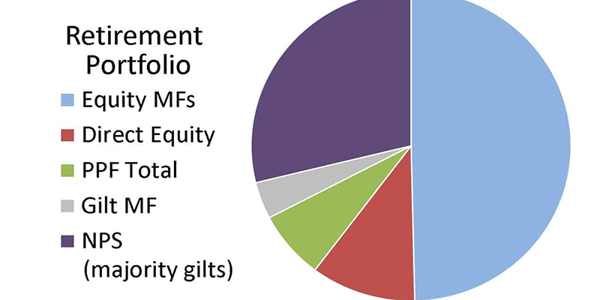Are you thinking about your financial future but not sure where to start? You're not alone.
A strong retirement portfolio ensures a comfortable and stress-free life after you stop working. But with so many investment options and financial advice, it's easy to feel overwhelmed.

How much should you save? Where should you invest? What strategies will help your money grow while keeping risks low?
Let's break it down so you can build a solid retirement portfolio that works for you.
Before diving into investment options, start by defining your retirement goals. Ask yourself:
• At what age do you plan to retire?
• How much money will you need each month to maintain your desired lifestyle?
• Do you plan to travel, buy a vacation home, or have expensive hobbies?
• Will you have additional income sources, like rental properties or a side business?
A rough estimate suggests retirees need about 70-80% of their pre-retirement income to maintain their standard of living. However, this number varies based on personal circumstances.
The more precise your goals, the easier it will be to create an investment strategy tailored to your needs.
A solid retirement portfolio is all about balance. You don’t want to put all your eggs in one basket, but you also don’t want to take on too much risk.
Investing in stocks provides growth potential. Historically, the stock market has delivered higher returns over the long term than other investment options. However, stocks can be volatile. That's why investing in a mix of individual stocks, index funds, or ETFs can be a smart strategy.
Example:
• Invest in S&P 500 index funds for steady, long-term growth.
• Consider dividend-paying stocks for passive income.
• Add a mix of domestic and international stocks to reduce risk.
Bonds are more stable than stocks and provide fixed income. They act as a safety net when the stock market is unpredictable. Government and corporate bonds can add a layer of security to your portfolio.
Example:
• Treasury bonds for low-risk, reliable income.
• Corporate bonds with high ratings for a balance of security and return.
Real estate can be an excellent retirement investment. Rental properties can provide steady income, while real estate investment trusts (REITs) allow you to invest in real estate without the hassle of managing properties.
Example:
• Buy a rental property in a growing market.
• Invest in REITs for diversified real estate exposure without direct ownership.
If you want to diversify further, consider alternative investments like:
• Gold & Silver: Hedge against inflation.
• Cryptocurrency: High-risk but potential for high reward (only a tiny portion of your portfolio should be allocated here).
• Annuities: Provide guaranteed income streams in retirement.
Using tax-advantaged accounts can maximize your savings. Here are some key options:
If your employer offers a 401(k), take full advantage of it—especially if there’s a company match. That’s free money!
Example:
If your employer matches 50% of contributions up to 6% of your salary, contribute to an Individual Retirement Account.
If you don’t have a 401(k) or want to supplement it, open an IRA (Traditional or Roth).
• Traditional IRA: Contributions are tax-deductible, but withdrawals are taxed in retirement.

• Roth IRA: Contributions are made with after-tax dollars, but withdrawals in retirement are tax-free.
If you have a high-deductible health plan, consider an HSA. It’s triple tax-advantaged:
1. Contributions are tax-deductible.
2. Growth is tax-free.
3. Withdrawals for qualified medical expenses are tax-free.
Plus, after age 65, you can withdraw money for any reason without penalty (though non-medical withdrawals are taxed like a traditional IRA).
Hidden fees can eat into your retirement savings. Be mindful of:
• Expense ratios on mutual funds & ETFs (Aim for 0.5% or lower).
• Advisor fees (1% may seem small but adds up over time).
• Transaction fees & commissions (Choose low-cost brokers).
Your investment strategy should evolve.
• Focus on growth.
• Invest aggressively in stocks.
• Take advantage of compounding.
• Shift some assets to bonds and real estate.
• Maximize contributions to retirement accounts.
• Pay off debts like your mortgage or student loans.
In Your 60s And Beyond:
• Reduce risk by moving more into bonds, annuities, and dividend-paying stocks.
• Focus on generating passive income for retirement.
• Start withdrawing from your accounts wisely (consider tax implications).
One of the most significant risks retirees face is outliving their money.
A good retirement portfolio accounts for:
The cost of living will increase, so your investments should outpace inflation.
People are living longer, meaning savings need to last 20-30+ years.
Medical expenses can rise unexpectedly. Having an HSA or long-term care plan can help.
Retirement planning isn’t a set-it-and-forget-it process. Markets fluctuate, personal circumstances change, and new opportunities arise. That’s why it’s essential to:
• Review your portfolio at least once a year.
• Rebalance assets to stay aligned with your goals.
• Adjust your risk level as you get older.
Pro Tip: Use the “Rule of 110” to determine your stock allocation:
• Subtract your age from 110. The result is the percentage of your portfolio that should be in stocks.
• Example: If you're 40, (110 - 40) = 70% in stocks, 30% in bonds and other assets.
A strong retirement portfolio isn’t built overnight. It takes planning, patience, and discipline. Start early, take advantage of tax-advantaged accounts, diversify your investments, and adjust your strategy as you age. The key is to stay consistent. Even small contributions can grow into significant wealth over time. Your future self will thank you. So, take action today and build a retirement portfolio that secures your financial freedom!